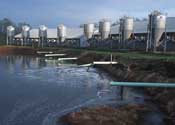
Appropriate substitution of manure for commercial fertilizer can reduce crop production costs by as much as $85 per acre for a 1,000-acre farm. Nationwide, doubling the application of manure-based nitrogen through a nutrient management plan could save agriculture about $1.2 billion worth of natural gas each year and save society up to 100 billion cubic feet of natural gas. It takes some 40,000 cubic feet of natural gas to produce a ton of commercial nitrogen fertilizer. Producers who use nitrogen-fixing legumes as cover crops or in crop rotations also can reduce their need for commercial fertilizer.
Nutrient management is a conservation practice that involves proper timing and placement of the right amounts of nutrients and soil amendments for adequate soil fertility and to minimize potential environmental degradation, particularly of water quality.
The Natural Resources Conservation Service (NRCS) works with owners and operators of animal feeding operations to develop nutrient management plans that are unique to each operation and achieve production and natural resource protection goals. A comprehensive nutrient management plan begins with a soil test. The plan incorporates conservation practices to use animal manure and organic by-products as a beneficial resource in amounts needed by growing crops.
Energy costs also may be reduced through use of anaerobic digesters, such as covered lagoons and complete mix digesters, coupled with electricity generation from methane. Manure from the anaerobic digesters provides a reliable level of nitrogen fertilization and can be used to replace commercial fertilizer. When stored and handled properly, animal manure loses less nitrogen and can be applied with confidence. NRCS can provide information and considerations for designing and constructing appropriate manure handling facilities.
Methane produced by the manure allows biogas generators to produce electricity and heat that producers can use onsite. Also, the potential exists to sell the excess electricity to a local electric grid. The Federal AgSTAR program estimates that 426,000 metric tons of methane may be recoverable for use in over 3,000 livestock facilities across the United States. Biogas systems are expensive initially, but have great potential for long-term cost efficiencies with large concentrations of livestock.
In addition, nutrient management provides environmental benefits, such as reducing animal manure odors, reducing surface and groundwater contamination, and eliminating weed seed and crop pathogens.
 Conservation Practices that Save: Nutrient Management
Conservation Practices that Save: Nutrient Management
 Download and open this feature using Adobe Acrobat
Download and open this feature using Adobe Acrobat
NRCS supports conservation practices that save producers money and improve the environmental health of the Nation. For more information on energy-saving conservation practices, visit the NRCS “Save ENERGY, Save MONEY” web site at www.nrcs.usda.gov.
Helping People Help the Land